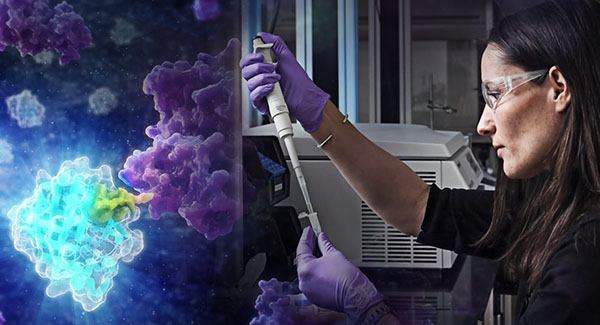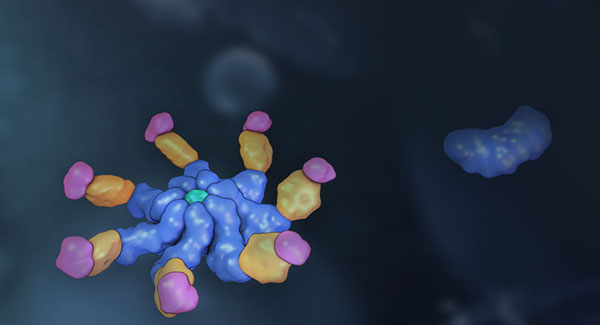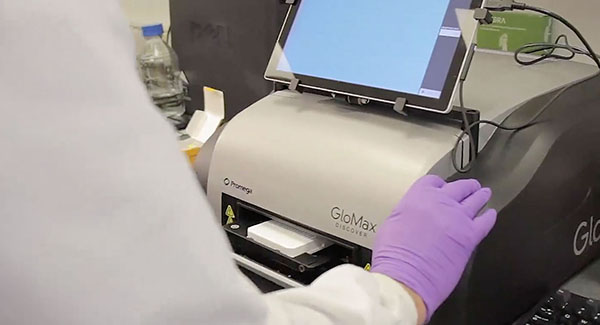Small Molecule Drug Discovery
The process of small molecule drug discovery can be complex and challenging. A typical workflow begins with hit identification and assay development, and carries through to preclinical candidate selection. High-throughput screening of drug candidates plays in essential role in the drug discovery process.
Promega offers a comprehensive selection of tools to accelerate drug discovery, based on an innovative, sensitive bioluminescence platform.
Solutions
GPCR Research
Measure the response at each step of the G-protein coupled receptor (GPCR) signaling cascade.
Kinase Biology
High-throughput biochemical and cellular assays to study kinase binding and inhibition
Inflammasome Activation
Assays and technologies to monitor inflammasome activation in live cells
Services

Support for CROs
Discover how Promega can help your contract research organization (CRO) develop better solutions for your clients.

Small Molecule Profiling and Assay Development
Partner with us to access our latest technologies and materials for drug discovery research and development.
Drug Discovery Conferences and Tradeshows
Promega scientists will be attending and speaking at key drug discovery conferences and tradeshows throughout the year. Join us to learn more about innovative solutions to accelerate your research.
| Event Name | 2023 Dates | Location | Presentations |
| DDR Inhibitors Summit | January 24–26 | Boston, MA | |
| Molecular Glue Drug Development Summit | January 24–26 | Boston, MA | View 2023 Presentation |
| 2nd GPCRs-Targeted Drug Discovery Summit | February 21–23 | Boston, MA | |
| Next Generation Kinase Inhibitors Summit | February 22–23 | Boston, MA | View 2023 Presentation |
| SLAS 2023 International Conference and Exhibition | February 25–March 1 | San Diego, CA | |
| Targeted Protein Degradation and Targeting the Undruggables | March 15–16 | Boston, MA | |
| 3rd Targeted Protein Degradation (TPD) Summit Europe | March 28–30 | London, England |
View 2023 Presentation View 2022 Presentation |
| DDC (Drug Discovery Chemistry) | April 10–13 | San Diego, CA | View 2022 Presentation |
| AACR (American Association of Cancer Research) | April 14–19 | Orlando, FL | |
| ASGCT (American Society of Gene and Cell Therapy) | May 16–20 | Los Angeles, CA | |
| CAR-TCR Therapies Summit | August 29–September 1 | Boston, MA | |
| RAS-TDD (RAS-Targeted Drug Development Summit) | September | Boston, MA | View 2022 Presentation |
| PDTU (Protein Degradation and Targeting Undruggables Congress) | September 13–14 | Basel, Switzerland | View 2022 Presentation |
| DOT (Discovery on Target) | September 25–28 | Boston, MA | |
| TPD (Targeted Protein Degradation 6th Annual Summit) | October | Boston, MA | View 2022 Presentation |
| 4th Gene Therapy Analytical Development |
November | to be determined | View 2022 Presentation |
| 5th Inflammasome Therapeutics Summit |
November | to be determined | View 2022 Presentation |
| 6th RNA-Targeted Drug Discovery Summit |
December 13–15 | to be determined | |
| TPD Assay Development and Screening Summit |
December | to be determined | View 2022 Presentation |
Request a Seminar
Interested in more information about small-molecule drug discovery?
We can customize a presentation to answer your questions.
About Small Molecule Drug Discovery
The pathway from identification of a novel drug candidate to preclinical trials can be complex. From screening compound libraries to measuring the interaction of a compound with its protein targets to examining the effects on cell health, the process of drug discovery relies on rapid, sensitive and high-throughput assays.
Technologies developed by Promega can help streamline the drug discovery process. NanoBRET® target engagement assays quantitatively measure target occupancy and compound affinity in live cells. A comprehensive collection of CRISPR-edited cell lines and clones with popular targets fused to a small bioluminescent tag, supports these live-cell assays. In addition, these engineered cells are ideal for studying the effects of degrader compounds, such as PROTACs, IMiDs and molecular glues, in real time. Bioluminescence technology also forms the basis for assays to examine signaling pathways in kinase biology and to study oncogenesis, such as the RAS signaling pathway.
Our small molecule drug discovery products and technologies are supported by a range of services, including our partnerships with CROs and early access to the latest research products and technologies through our Elite Access program.
Featured Resources

Webinar: Designing Successful Targeted Protein Degradation Assays
Our TPD experts address commonly asked questions and share best practices for developing degrader assays.

Webinar: Quantifying Inflammasome Activation and Target Engagement
Learn about a live-cell BRET target engagement assay for the NLRP3 inflammasome.

Video: Target Engagement Case Study
Learn how Aurelia Bioscience used NanoBRET® technology to measure kinase target engagement under more physiologically relevant conditions.